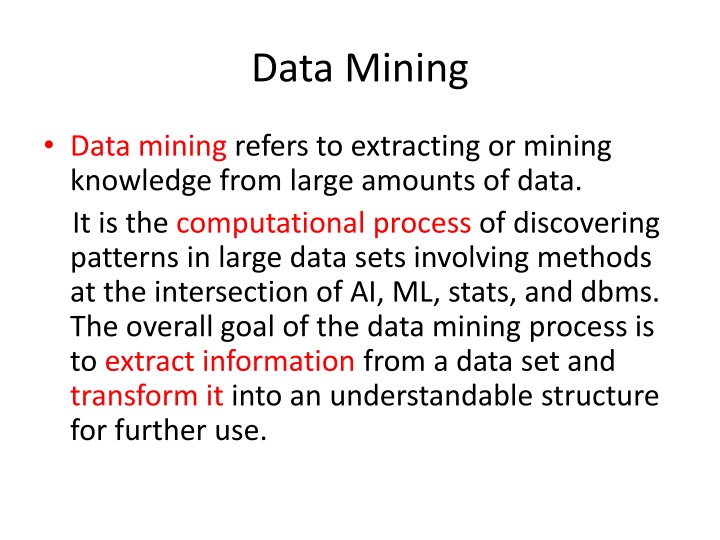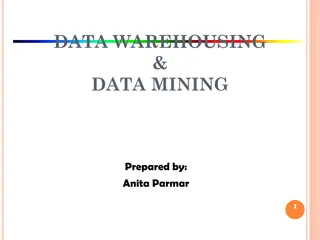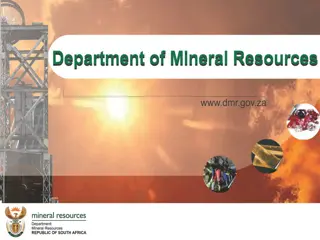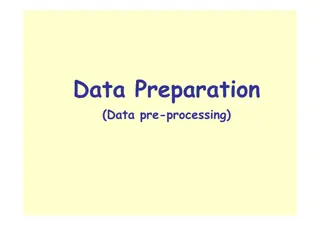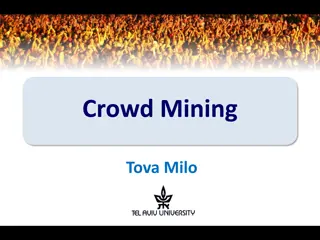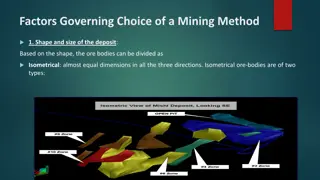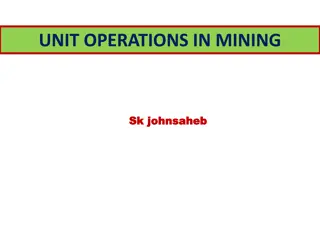Data Mining: Processes and Applications
Data mining involves extracting knowledge from large data sets using computational methods at the intersection of AI, ML, stats, and DBMS. It aims to discover patterns and transform data into actionable insights for various applications such as predictive modeling and anomaly detection.
Download Presentation

Please find below an Image/Link to download the presentation.
The content on the website is provided AS IS for your information and personal use only. It may not be sold, licensed, or shared on other websites without obtaining consent from the author.If you encounter any issues during the download, it is possible that the publisher has removed the file from their server.
You are allowed to download the files provided on this website for personal or commercial use, subject to the condition that they are used lawfully. All files are the property of their respective owners.
The content on the website is provided AS IS for your information and personal use only. It may not be sold, licensed, or shared on other websites without obtaining consent from the author.
E N D
Presentation Transcript
Data Mining Data mining refers to extracting or mining knowledge from large amounts of data. It is the computational process of discovering patterns in large data sets involving methods at the intersection of AI, ML, stats, and dbms. The overall goal of the data mining process is to extract information from a data set and transform it into an understandable structure for further use.
Key properties of data mining Automatic discovery of patterns Prediction of likely outcomes Creation of actionable information Focus on large datasets and databases
Scope of Data Mining 1. Automated prediction of trends and behaviors: Data mining automates the process of finding predictive information in large databases. A typical example of a predictive problem is targeted marketing. Data mining uses data on past promotional mailings to identify the targets most likely to maximize return on investment in future mailings. Other predictive problems include forecasting bankruptcy and other forms of default, and identifying segments of a population likely to respond similarly to given events
Scope of Data Mining 2. Automated discovery of previously unknown patterns: Data mining tools sweep through databases and identify previously hidden patterns in one step. An example of pattern discovery is the analysis of retail sales data to identify seemingly unrelated products that are often purchased together. Other pattern discovery problems include detecting fraudulent credit card transactions and identifying anomalous data that could represent data entry keying errors
Tasks of Data Mining 1. Anomaly detection (Outlier/change/deviation detection): The identification of unusual data records, that might be interesting or data errors that require further investigation. 2. Association rule learning (Dependency modelling) Searches for relationships between variables. For example a supermarket might gather data on customer purchasing habits. Using association rule learning, the supermarket can determine which products are frequently bought together and use this information for marketing purposes. This is sometimes referred to as market basket analysis.
Tasks of Data Mining 3. Clustering is the task of discovering groups and structures in the data that are in some way or another "similar", without using known structures in the data. 4. Classification is the task of generalizing known structure to apply to new data. For example, an e-mail program might attempt to classify an e-mail as "legitimate" or as "spam".
Tasks of Data Mining 5. Regression: attempts to find a function which models the data with the least error. 6. Summarization: providing a more compact representation of the data set, including visualization and report generation
Major Issues In Data Mining 1. Mining different kinds of knowledge in databases: The need of different users is different. It is necessary for data mining to cover broad range of knowledge discovery task. 2. Interactive mining of knowledge at multiple levels of abstraction: The data mining process needs to be interactive because it allows users to focus the search for patterns, providing and refining data mining requests based on returned results.
Major Issues In Data Mining 3. Incorporation of background knowledge: To guide discovery process and to express the discovered patterns, the background knowledge can be used. Background knowledge may be used to express the discovered patterns not only in concise terms but at multiple level of abstraction. 4. Data mining query languages and ad hoc data mining: should be integrated with a data warehouse query language and optimized for efficient and flexible data mining.
Major Issues In Data Mining 5. Presentation and visualization of data mining results: Once the patterns are discovered it needs to be expressed in high level languages, visual representations. This representations should be easily understandable by the users. 6. Data cleaning methods to handle noise and incomplete objects while mining the data regularities. If data cleaning methods are not there then the accuracy of the discovered patterns will be poor
Major Issues In Data Mining 7. Efficiency and scalability of data mining algorithms: For effective extraction, data mining algorithm must be efficient and scalable. 8. Parallel, distributed, and incremental mining algorithms: These algorithm divide the data into partitions which is further processed parallel. Then the results from the partitions is merged. The incremental algorithms, updates databases without having mine the data again from scratch
